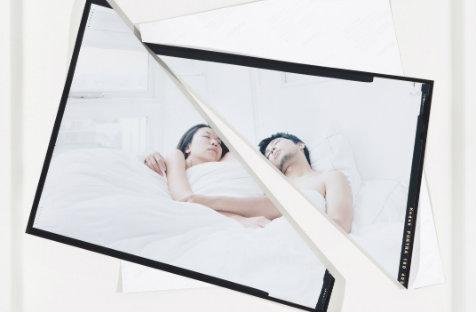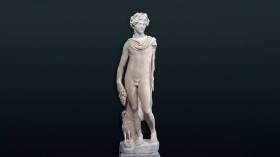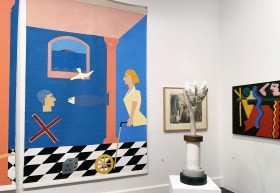The folded lines of Paul Knight’s colour photographs seem to possess an emotional charge; they come to represent closeness or distance, intimacy or lack thereof, between the couples he portrays. Folded works, from the series Intimate Couples, have a personal, unstaged quality. In one image a sleeping couple embrace each other, a fold runs between their bodies with the two halves of the photograph being separated along this line and revealing a possible rift or distance in their relationship. In other images, folded edges have been placed so close to one another that the couples’ bodies seem to mould into one. Set off to one side, behind an angled, screen-like extension to the wall are three photographs of a homosexual couple touching erotically. Photographed from above against bright blue sheets their entangled bodies create sharply contrasting shapes in their pale whiteness. The positioning of these photographs to one side, separated, gives an increased sense of intimacy, as if you are looking in on a very private scene, but also seems to echo the uncomfortable idea of homosexuality being hidden away.
These angled, screen-like wall extensions illustrate the architectural reconsidering of the Franco and Amina Belgiorno-Nettis and Family Contemporary Galleries at the Art Gallery of NSW, for the first time since 1988. Curator Natasha Bullock worked with Minifie van Schaik Architects to re-imagine the galleries, adding an architectural dimension to the current exhibition, We used to talk about love. Walls jut out at many different angles, while skylights draw the eye upwards and have an almost honeycomb like quality.
The exhibition includes 11 Australian artists who have all lived and worked internationally for extended periods, and is divided into four sections to explore the multifaceted nature of a subject as vast as love. Paul Knight, Polly Borland and Angelica Mesiti’s work form the first section called ‘To begin with the flesh’. Their works explore love’s inextricable link to sex, intimacy and eroticism; in the case of Mesiti’s work, she explores the more spiritual and sensual dimensions. Particular focus is placed on the emotional dimensions of love throughout the exhibition. The second section is titled ‘Expressive abstraction’ and features the work of Darren Sylvester and David Rosetzky. Works by Eliza Hutchison, David Noonan and Justene Williams form ‘The archive of feeling’.
Justene Williams’ installation milk seeped in bread and rocked the leg creates an interior space, both within the gallery and in her video works. Williams’ video works allude to childhood play and domestic activities but in an absurd or nonsensical way. Inspired by Dada and the Cabaret Voltaire nightclub in Zurich, Williams’ characters are dressed in white lycra bodysuits with gnarled, craggy white faces and wigs. They move chess pieces around in a seemingly willy-nilly way, apples are attached to coat hangers, and participants play with bread and string. Through the absurd and surreal, Williams’ work explores a number of different things, including the familial dimensions of love, feelings, memory and the domestic. Her parents are participants in her video work.
The show concludes with ‘Filthy crushing ending’, featuring the work of Glenn Sloggett, Grant Stevens and perhaps the most anticipated work in the show, Tim Silver’s Untitled (Rory grown up…).
Silver has created a life-size cast of his own body; painted blue with watercolour pigment, the cast will slowly disintegrate over the months of the exhibition, water droplets gently falling onto this half-naked young man’s head as he gazes towards the heavens. The work has already fallen: ‘Rory’ lies on his back on the gallery floor, succumbing to the force of gravity before the forces of disintegration. It remains to be seen if the work will be propped back up or left as it now lies. The first photograph of the work was taken at the show’s opening; it hangs on the gallery wall, showing the work in its original upright position. The disintegration of the work will be documented periodically throughout the exhibition.
The breakdown of the exhibition into sections allows certain comparisons between artists to be made and for a more clearly delineated path to emerge through this exploration of love. Curator Natasha Bullock describes the exhibition as ‘charting an emotional arc from bodily beginnings of love … to its potentially crushing conclusions’.
The exhibition title seems to beg a question: if we used to talk about love, what do we talk about now? No clear answer is given to this difficult question; rather, a diverse range of works in a variety of mediums explore different aspects of love. From the sexual and the spiritual to the non-sexual and familial incarnations, ending in the loss and despair of broken hearts, longing and anguish.
Rating: 3 ½ stars out of 5
We used to talk about love
Balnaves contemporary: photomedia
Curated by Natasha Bullock
Art Gallery of New South Wales, Sydney
31 January – 21 April






